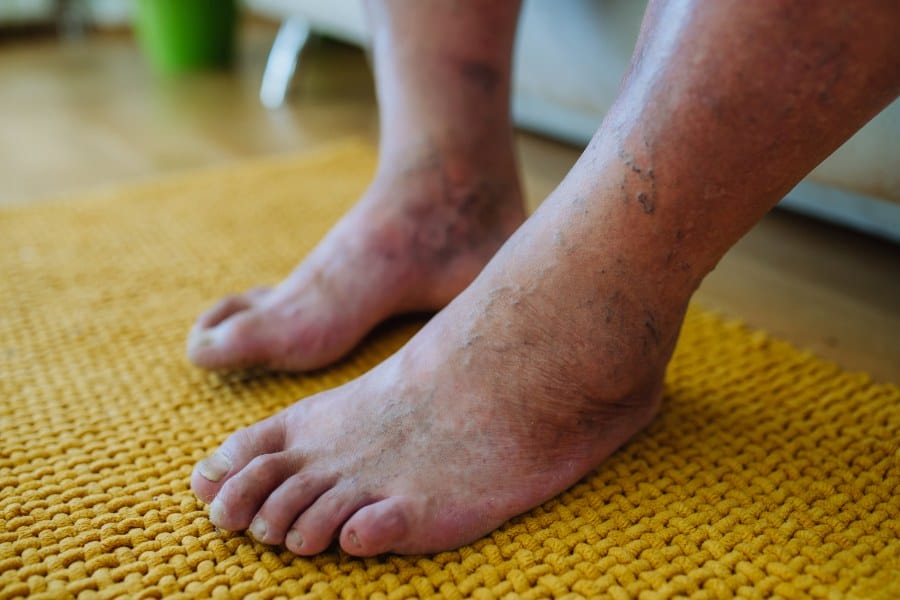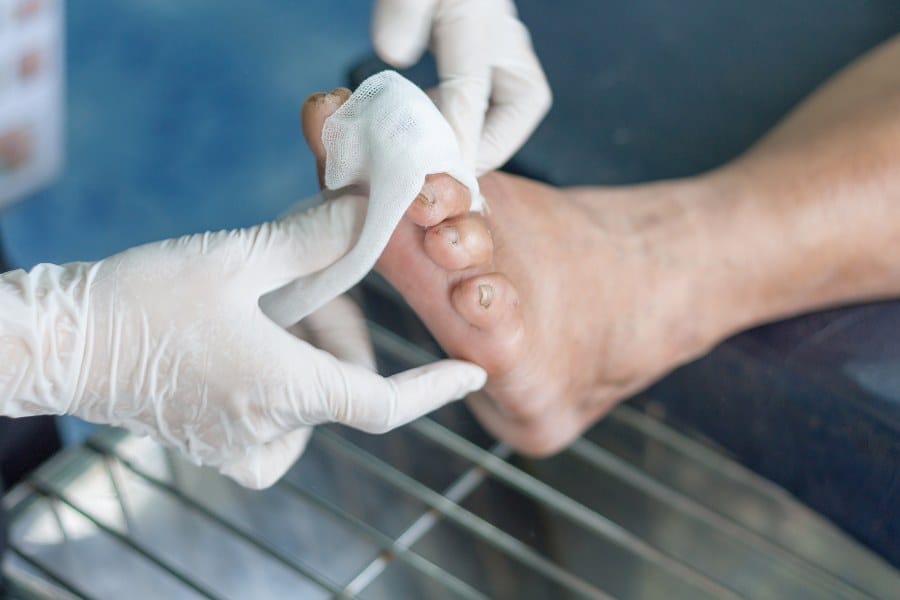Diabetic Foot Care Nursing Procedure
IN THIS ARTICLE
In 2012 American Diabetes Association data showed that 29.1 million Americans or 9.3% of the population had diabetes.
This figure includes 11.8 million seniors. (ADA) Seniors often experience many health issues which frequently lead to hospitalization.
In fact, additional research done by the ADA found that patients with diabetes were most commonly admitted to the hospital for comorbidities, resulting in diabetic care largely being overlooked.
At discharge, these patients are often referred for home care services based on their other health concerns; referrals for diabetes care only are rare.
But a diabetes diagnosis can lead to many complications and greatly contributes to health care expenses.
“After adjusting for population age and sex differences, average medical expenditures among people with diagnosed diabetes were 2.3 times higher than what expenditures would be in the absence of diabetes.” (ADA)
Diabetes comes with several complications and is often not treated as seriously as it should be.
While a nurse may be in the home of a patient because of a different health issue, it is important to also perform appropriate diabetic care to avoid further complications.
Click here to go directly to the nursing care of diabetic foot instructions.
What is Diabetic Foot?

Diabetic foot is a condition that occurs as a result of high blood sugar levels in people with diabetes. The condition affects the feet and can cause severe damage to the nerves and blood vessels, leading to poor circulation and reduced sensation in the feet.
The reduced sensation makes it difficult for people with diabetic foot to feel pain, heat or cold, which can result in the development of ulcers, infections, and other complications.
The pathophysiology of diabetic foot involves various factors, including peripheral neuropathy, peripheral arterial disease, and foot deformities.
Peripheral neuropathy is a condition that causes damage to the nerves that control the movement and sensation of the feet.
The condition can result in numbness, tingling, and loss of sensation in the feet. Peripheral arterial disease, on the other hand, is a condition that affects the blood vessels that supply blood to the feet.
Foot deformities, such as bunions and hammertoes, also increase the risk of developing diabetic foot.
Risk Factors of Diabetic Foot
Several risk factors can increase the risk of developing diabetic foot. These include:
- Poor blood sugar control
- Smoking
- High blood pressure
- High cholesterol levels
- Obesity
- Family history of foot problems
- Previous foot injuries or infections
People with diabetes who have one or more of these risk factors should be extra vigilant about their foot care.
Regular foot examinations, comfortable special shoes, proper foot hygiene, and appropriate footwear can help prevent the development of diabetic foot complications.
How Foot Complications Can Occur
Of all diabetes-specific hospital admissions, 20 – 25% of them are for foot complications. (Reynolds)
These problems can occur frequently in diabetics for several reasons. First, diabetics can suffer from peripheral neuropathy, causing a loss of feeling in their feet.
This makes it difficult to recognize cuts or ulcers on the foot because they cannot feel pain as they once did. A cut, callus, or blister can be present and the patient might not have any idea.
It may also be hard for an elderly or overweight person to check and clean their own feet easily, meaning they aren’t able to inspect their feet regularly and any injury will continue to go unnoticed.
Another issue is peripheral artery disease, which many people with diabetes have as well. This causes poor blood flow to the extremities, which in turn decreases sensation and healing. (ADA) Thus, diabetics can have foot sores that go unnoticed and untreated for so long and infection can easily occur.
Severe Cases
Once a sore or blister requires medical attention, treatment varies depending on the severity of the wound and the infection.
X-rays may be needed to see if the infection has spread to the bone.
A hospital admission may be required if the wound needs to be cleaned and debrided. Antibiotics will need to be administered. If the wound still isn’t healing or if the infection gets worse, amputation of the affected foot can even be necessary. (ADA)
With that said, let’s get into the nursing care for diabetic foot.
Prevention with Home Care Nursing
Diabetic foot problems are largely preventable with proper diabetes management, including diet, exercise, and careful monitoring of blood sugar levels.
This is where a visiting nurse can assist in preventing these complications. It is important that diabetes management be identified as a concern for the visiting nurse so that maintenance is included in the patient’s plan of care.
A diabetes diagnosis is often put on the back burner of elderly care as the focus is placed on other comorbidities. (Linekin)
The home care nurse can address the issues that can help prevent diabetic foot complications while treating the patient for other health issues.
To start, the home care nurse should assess how well the patient is managing the disease in order to try to prevent foot problems from occurring from the start.
Make sure the patient is adhering to a balanced diet, getting enough exercise, and adequately monitoring their blood sugars.
Education is key to prevention and wellness. Review diet and exercise requirements and make sure the patient knows how to use their glucometer.
Nursing Care of Diabetic Foot

The following is a list of interventions that should be performed by the nurse or caregiver to prevent and monitor diabetic foot complications.
The patient should also be taught how to do these tasks whenever possible and encouraged to perform them regularly.
- Inspect the feet, examining for any cuts or sores. This includes diabetic foot ulcers. Look for dry, cracked skin and redness, warmth, or tenderness. Contact the physician if anything is found. Instruct the patient not to self treat any corns or calluses.
- Wash with warm water, dry, and moisturize the patient’s feet. Make sure the water is not too hot and pat dry the feet thoroughly when finished. Mild soap and lotion can be used on dry skin, but avoid the areas between the toes as this could lead to excessive moisture.
- Instruct the patient to avoid walking barefoot.
- Encourage use of comfortable, well fitting shoes that allow the feet to breathe and offer adequate support.
- Wear loose fitting socks made of natural fibers and change them daily.
- Protect the patient’s feet from hot and cold extremes. Tell the patient to avoid heating pads and to double check the temperature of water with a hand or elbow before placing the foot in it.
- Trim toenails straight across. Avoid cutting into the corners. If the patient is unable to do this on their own, instruct them to have their physician take care of it when they are in the office.
- Encourage the patient to stop smoking if applicable.
- Discourage the patient from crossing their legs as this diminishes sensation and blood supply. (NIDDK, Pietrangelo, Ann)
- Suggest consistent foot exams from a foot doctor, if possible, too
With adequate diabetes management and these preventative steps, it is possible to avoid the serious foot complications that can result from this disease. Even though the nurse may be in the home to provide care for other diagnoses, care for a diabetes diagnosis is also an important part of the nurse’s role.
Diabetic Foot Preventative Measures for Patients
Daily Foot Inspections
One of the most important preventive measures for diabetic foot care is conducting daily foot inspections.
Patients with diabetes should inspect their feet daily to detect any signs of injury, infection, or other abnormalities.
This can be done by visually examining the feet, checking for swelling, redness, blisters, cuts, or any other changes in the skin or nails.
Patients should also use their hands to feel for any areas of tenderness or sensitivity. If any abnormalities are detected, patients should promptly seek medical attention.
Proper Footwear Selection
Proper footwear selection is another important preventive measure for diabetic foot care.
Patients with diabetes should wear shoes that fit well and provide adequate support and protection. Shoes should be comfortable and not cause any rubbing or irritation on the feet.
Patients should avoid wearing sandals, flip-flops, or any shoes that expose the toes or heels. Shoes with closed toes and heels are recommended. Patients should also avoid walking barefoot, even at home, to reduce the risk of injury.
Glycemic Control
Glycemic control is crucial for preventing diabetic foot complications.
High blood sugar levels can damage nerves and blood vessels in the feet, which can lead to decreased sensation and poor circulation. Patients with diabetes should monitor their blood sugar levels regularly and follow their healthcare provider’s recommendations for managing their diabetes.
This may include taking medications, following a healthy diet, and engaging in regular physical activity. By maintaining good glycemic control, patients can reduce their risk of developing diabetic foot complications.
Frequently Asked Questions About Diabetic Foot
What are the best practices for maintaining healthy feet with diabetes?
Maintaining healthy feet with diabetes requires a comprehensive approach that includes regular foot care, proper footwear, and healthy lifestyle habits. Some of the best practices for maintaining healthy feet with diabetes include daily inspection of the feet, washing and drying the feet daily, wearing properly fitting shoes and socks, avoiding going barefoot, and keeping the feet moisturized.
How can someone with diabetes prevent foot complications?
Preventing foot complications in individuals with diabetes involves managing blood sugar levels, maintaining healthy lifestyle habits, and practicing good foot care. Some tips to prevent foot complications include regular exercise, maintaining a healthy diet, avoiding smoking, wearing proper footwear, and regularly visiting a podiatrist or healthcare provider.
What are the warning signs that indicate a problem with diabetic feet?
Individuals with diabetes should watch out for warning signs that may indicate a problem with their feet. Some of these warning signs include numbness or tingling in the feet, cuts or sores that do not heal, swelling in the feet, redness or warmth in the feet, and changes in the shape or color of the feet.
What is the recommended daily foot care routine for individuals with diabetes?
The recommended daily foot care routine for individuals with diabetes includes washing and drying the feet daily, inspecting the feet for cuts, sores, or other abnormalities, moisturizing the feet with lotion, wearing properly fitting shoes and socks, and avoiding going barefoot. Opting for nursing care for diabetic foot is recommended.
Which products are considered essential for proper diabetic foot care?
Some essential products for proper diabetic foot care include a mild soap for washing the feet, a moisturizing lotion, properly fitting shoes and socks, and a pumice stone or foot file for removing calluses and dry skin.
Why is it important to have regular foot examinations for diabetic patients?
Regular foot examinations are important for diabetic patients because they can help detect foot problems early, before they become more serious. A podiatrist or healthcare provider can check for signs of nerve damage, circulation problems, and other foot conditions that may require treatment.
Sources
American Diabetes Association. http://www.diabetes.org/
Hirschman, Karen and M. Brian Bixby. 8/2014. Transitions in Care from Hospital to Home for Patients with Diabetes. http://spectrum.diabetesjournals.org/content/27/3/192?trendmd-shared=0
Linekin, Patricia Landi. 10/2003. Home Health Care and Diabetes Assessment, Care and Education. http://spectrum.diabetesjournals.org/content/16/4/217
National Institute of Diabetes and Digestive and Kidney Diseases. Take Care of Your Feet for a Lifetime. https://www.niddk.nih.gov/health-information/diabetes/preventing-diabetes-problems/keep-feet-healthy/take-care-your-feet-lifetime
Pietrangelo, Ann. 4/2016. Diabetes Foot Care. http://www.healthline.com/health/diabetes-foot-care#Healthyfoothabits3
Reynolds, Chelsea. Why Good Footcare is Important for Diabetes. http://www.diabeticlivingonline.com/complications/feet/why-good-foot-care-important-diabetes
WebMD. Diabetes Foot Care. http://www.webmd.com/diabetes/caring-feet#1





